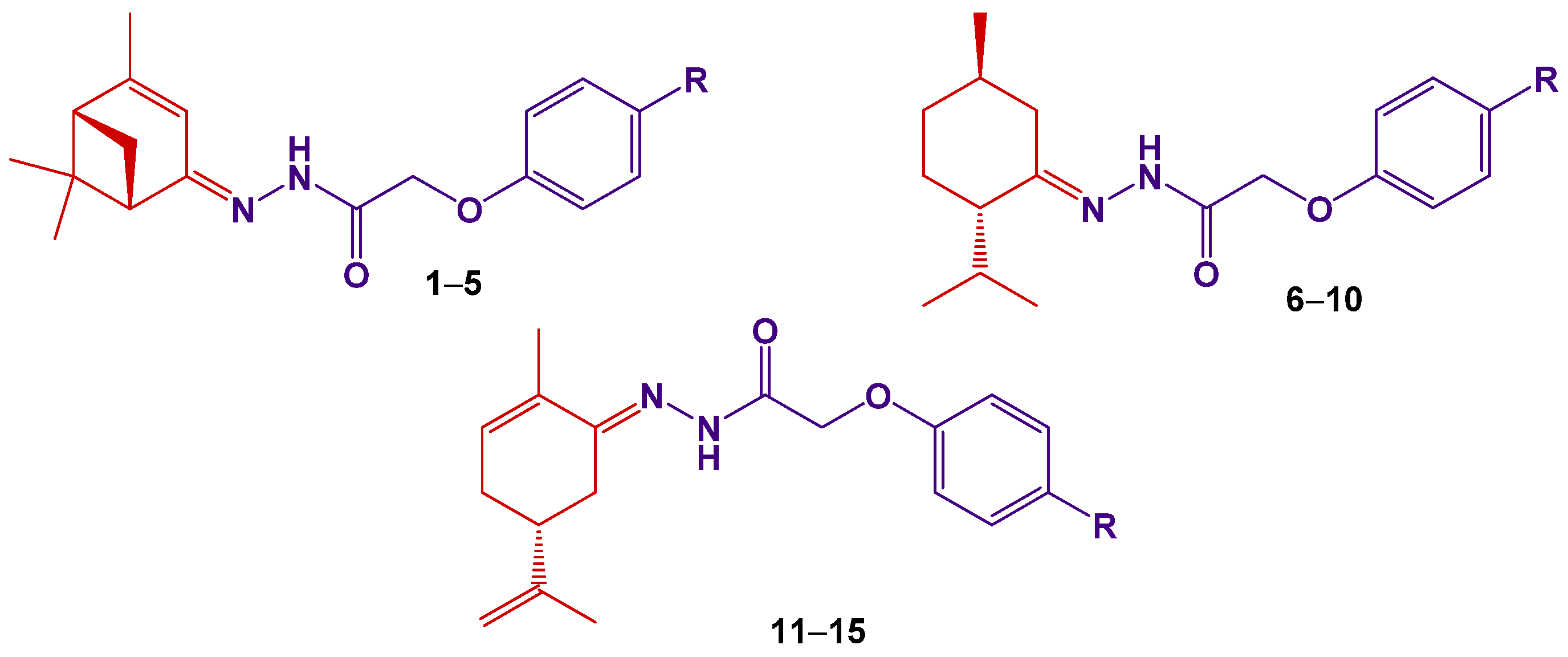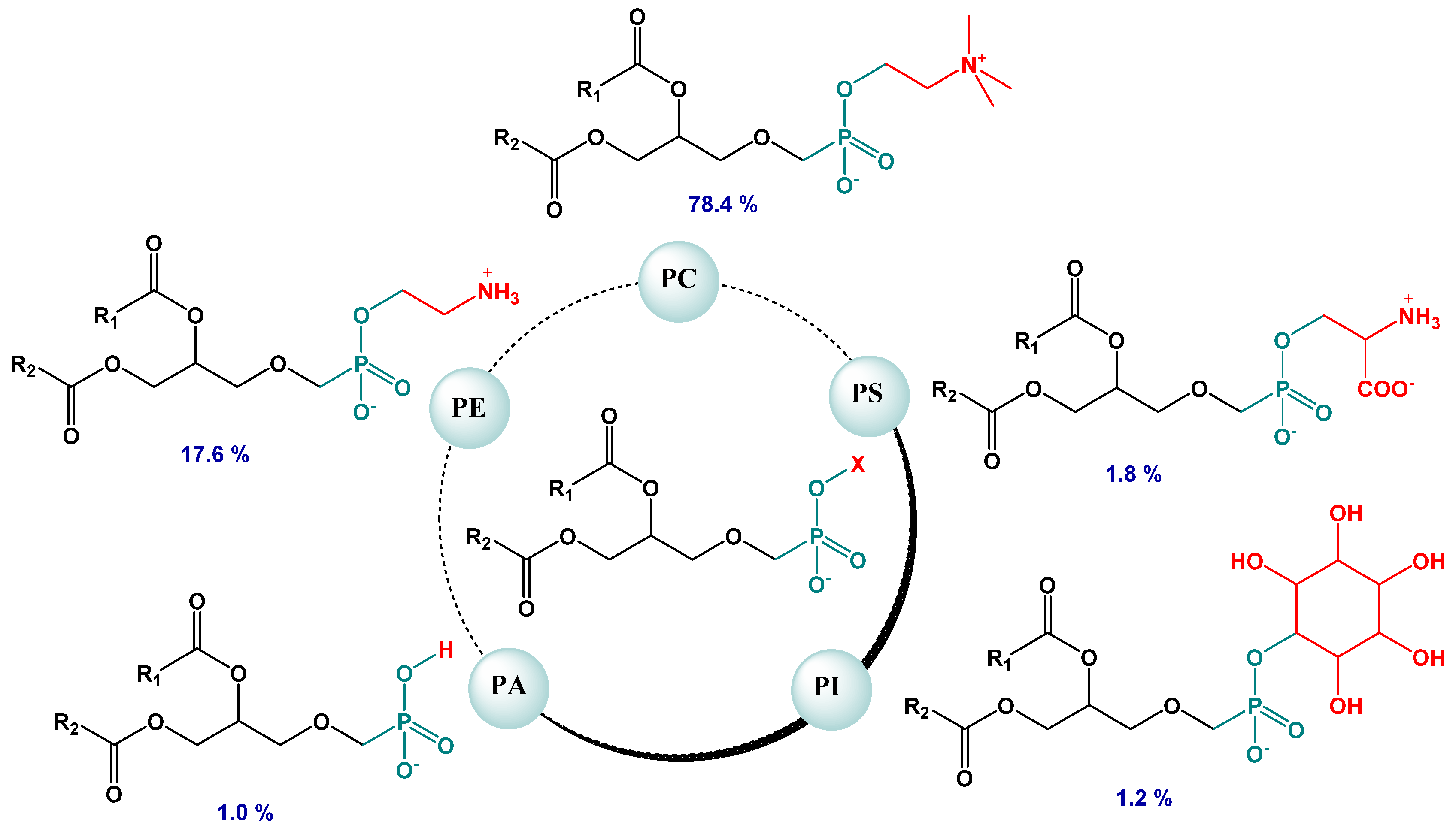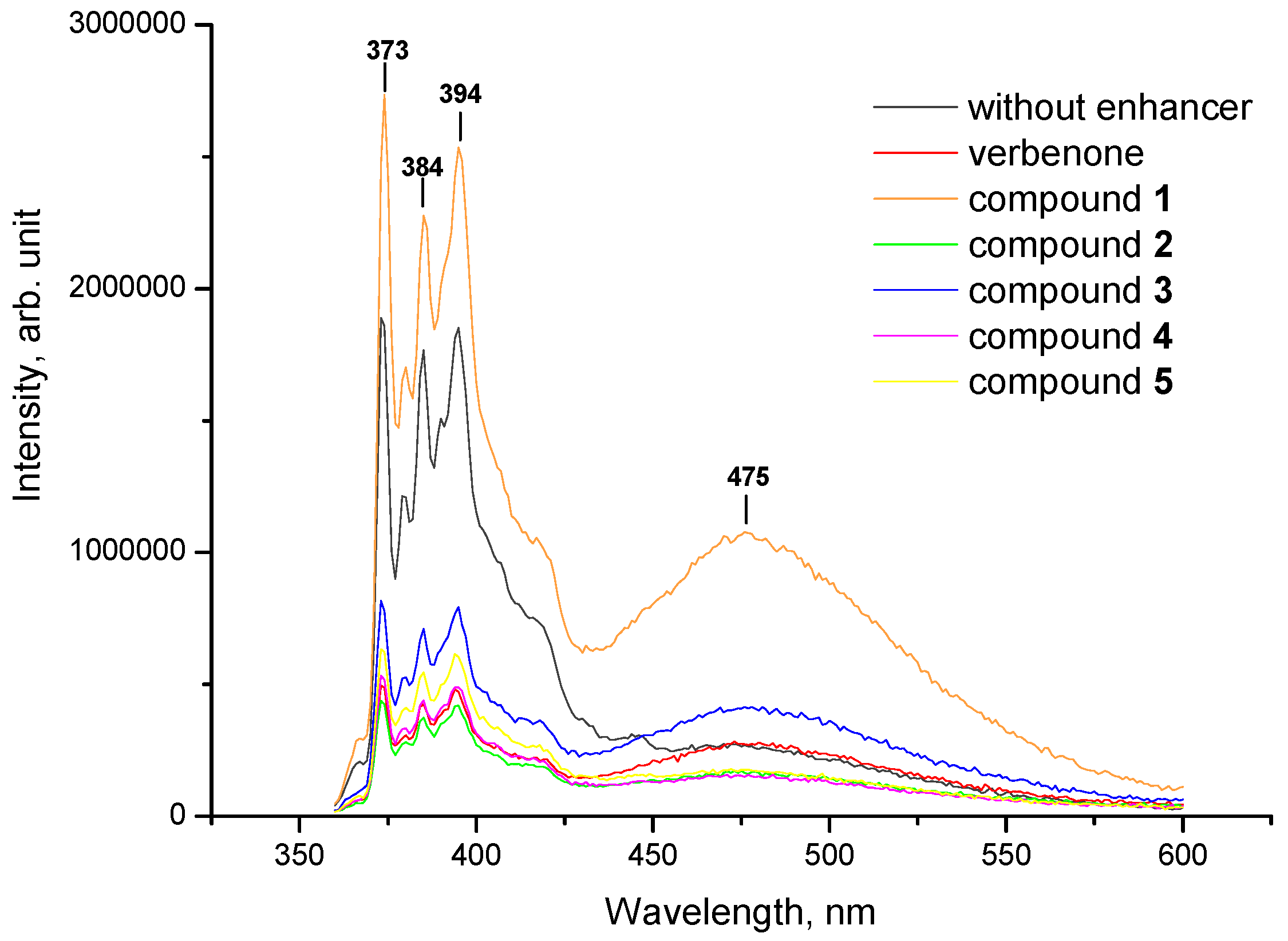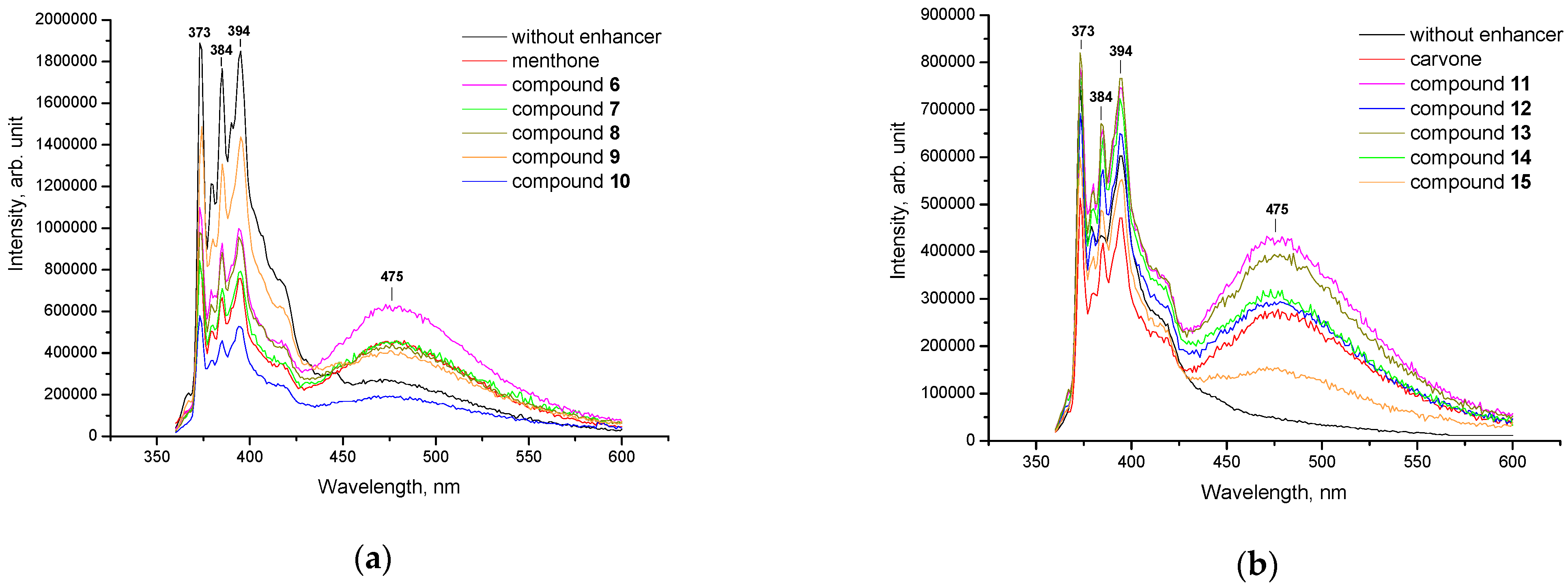Terpenoid Hydrazones as Biomembrane Penetration Enhancers: FT-IR Spectroscopy and Fluorescence Probe Studies
Abstract
:1. Introduction
2. Results and Discussion
2.1. Pyrene Fluorescence Studies
2.2. FT-IR Spectroscopy Investigation
3. Materials and Methods
3.1. General
3.2. Liposome Preparation
3.3. Determination of Liposome Size Distribution
3.4. Fluorescence Measurements
3.5. Experimental Animals
3.6. Isolation of Stratum Corneum
3.7. Extraction of SC Lipids
3.8. FT-IR Spectroscopy
3.9. Statistical Analysis
4. Conclusions
Supplementary Materials
Author Contributions
Funding
Institutional Review Board Statement
Informed Consent Statement
Data Availability Statement
Conflicts of Interest
Sample Availability
References
- Aungst, B.J. Absorption enhancers: Applications and advances. AAPS J. 2012, 14, 10–18. [Google Scholar] [CrossRef] [Green Version]
- Prausnitz, M.; Langer, R. Transdermal drug delivery. Nat. Biotechnol. 2008, 26, 1261–1268. [Google Scholar] [CrossRef] [PubMed]
- N’Da, D.D. Prodrug strategies for enhancing the percutaneous absorption of drugs. Molecules 2014, 19, 20780–20807. [Google Scholar] [CrossRef] [PubMed] [Green Version]
- Wang, J.J.; Sung, K.C.; Huang, J.F.; Yeh, C.H.; Fang, J.Y. Ester prodrugs of morphine improve transdermal drug delivery: A mechanistic study. J. Pharm. Pharmacol. 2007, 59, 917–925. [Google Scholar] [CrossRef] [PubMed]
- Stinchcomb, A.I.; Swaan, P.W.; Ekabo, O.; Harris, K.K.; Browe, J.; Hammell, D.C.; Cooperman, T.A.; Pearsall, M. Straight-chain naltrexone ester prodrugs: Diffusion and concurrent esterase biotransformation in human skin. J. Pharm. Sci. 2002, 91, 2571–2578. [Google Scholar] [CrossRef]
- Qandil, A.; Al-Nabulsi, S.; Al-Taani, B.; Tashtoush, B. Synthesis of piperazinylalkyl ester prodrugs of ketorolac and their in vitro evaluation for transdermal delivery. Drug Dev. Ind. Pharm. 2008, 34, 1054–1063. [Google Scholar] [CrossRef]
- Kiptoo, P.K.; Paudel, K.S.; Hammell, D.C.; Pinninti, R.R.; Chen, J.; Crooks, P.A.; Stinchcomb, A.L. Transdermal delivery of bupropion and its active metabolite, hydroxybupropion: A prodrug strategy as an alternative approach. J. Pharm. Sci. 2009, 98, 583–594. [Google Scholar] [CrossRef] [Green Version]
- Kerr, D.; Roberts, W.; Tebbett, I.; Sloan, K.B. 7-Alkylcarbonyloxymethyl prodrugs of theophylline: Topical delivery of theophylline. Int. J. Pharm. 1998, 167, 37–48. [Google Scholar] [CrossRef]
- Morris, A.P.; Brain, K.R.; Heard, C.M. Skin permeation and ex vivo skin metabolism of O-acyl haloperidol ester prodrugs. Int. J. Pharm. 2009, 367, 44–50. [Google Scholar] [CrossRef]
- Chen, J.; Jiang, Q.-D.; Chai, Y.-P.; Zhang, H.; Peng, P.; Yang, X.-X. Natural terpenes as penetration enhancers for transdermal drug delivery. Molecules 2016, 21, 1709. [Google Scholar] [CrossRef] [Green Version]
- Cox-Georgian, D.; Ramadoss, N.; Dona, C.; Basu, C. Therapeutic and medicinal uses of terpenes. In Medicinal Plants; Joshee, N., Dhekney, S., Parajuli, P., Eds.; Springer: Cham, Switzerland, 2019; pp. 333–359. [Google Scholar] [CrossRef]
- Nóbrega de Almeida, R.; Agra, M.d.F.; Negromonte Souto Maior, F.; De Sousa, D.P. Essential oils and their constituents: Anticonvulsant activity. Molecules 2011, 16, 2726–2742. [Google Scholar] [CrossRef] [PubMed]
- Wang, C.-Y.; Chen, Y.-W.; Hou, C.-Y. Antioxidant and antibacterial activity of seven predominant terpenoids. Int. J. Food Prop. 2019, 22, 230–238. [Google Scholar] [CrossRef] [Green Version]
- De Sousa, D.P. Analgesic-like activity of essential oils constituents. Molecules 2011, 16, 2233–2252. [Google Scholar] [CrossRef] [Green Version]
- Nesterkina, M.; Smola, S.; Kravchenko, I. Effect of esters based on terpenoids and GABA on fluidity of phospholipid membranes. J. Liposome Res. 2019, 29, 239–246. [Google Scholar] [CrossRef]
- Nesterkina, M.; Kravchenko, I. Synthesis and pharmacological properties of novel esters based on monocyclic terpenes and GABA. Pharmaceuticals 2016, 9, 32. [Google Scholar] [CrossRef] [Green Version]
- Premkumar, L.S. Transient receptor potential channels as targets for phytochemicals. ACS Chem. Neurosci. 2014, 5, 1117–1130. [Google Scholar] [CrossRef] [Green Version]
- Manayi, A.; Nabavi, S.M.; Daglia, M.; Jafari, S. Natural terpenoids as a promising source for modulation of GABAergic system and treatment of neurological diseases. Pharmacol. Rep. 2016, 68, 671–679. [Google Scholar] [CrossRef]
- Pages, N.; Maurois, P.; Bac, P.; Eynde, J.J.V.; Tamariz, J.; Labarrios, F.; Chamorro, G.; Vamecq, J. The α-asarone/clofibrate hybrid compound, 2-methoxy-4-(2-propenyl)phenoxyacetic acid (MPPA), is endowed with neuroprotective and anticonvulsant potentialities. Biomed. Aging Pathol. 2011, 1, 210–215. [Google Scholar] [CrossRef]
- Turan-Zitouni, G.; Yurttaş, L.; Kaplancıklı, Z.A.; Can, Ö.D.; Özkay, Ü.D. Synthesis and anti-nociceptive, anti-inflammatory activities of new aroyl propionic acid derivatives including N-acylhydrazone motif. Med. Chem. Res. 2015, 24, 2406–2416. [Google Scholar] [CrossRef]
- Nesterkina, M.; Barbalat, D.; Zheltvay, I.; Rakipov, I.; Atakay, M.; Salih, B.; Kravchenko, I. (2S,5R)-2-Isopropyl-5-methylcyclohexanone hydrazones. Molbank 2019, 2019, 1062. [Google Scholar] [CrossRef] [Green Version]
- Nesterkina, M.; Barbalat, D.; Kravchenko, I. Design, synthesis and pharmacological profile of (−)-verbenone hydrazones. Open Chem. 2020, 18, 943–950. [Google Scholar] [CrossRef]
- Nesterkina, M.; Barbalat, D.; Konovalova, I.; Shishkina, S.; Atakay, M.; Salih, B.; Kravchenko, I. Novel (‒)-carvone derivatives as potential anticonvulsant and analgesic agents. Nat. Prod. Res. 2021, 35, 4978–4987. [Google Scholar] [CrossRef]
- Ahad, A.; Aqil, M.; Ali, A. The application of anethole, menthone, and eugenol in transdermal penetration of valsartan: Enhancement and mechanistic investigation. Pharm. Biol. 2016, 54, 1042–1051. [Google Scholar] [CrossRef] [Green Version]
- Suhonen, M.; Li, S.K.; Higuchi, W.I.; Herron, J.N. A liposome permeability model for stratum corneum lipid bilayers based on commercial lipids. J. Pharm. Sci. 2008, 97, 4278–4293. [Google Scholar] [CrossRef] [PubMed]
- Reddy, A.S.; Zhang, S. Polypharmacology: Drug discovery for the future. Expert. Rev. Clin. Pharmacol. 2013, 6, 41–47. [Google Scholar] [CrossRef] [PubMed] [Green Version]
- Masnoon, N.; Shakib, S.; Kalisch-Ellett, L.; Caughey, G.E. What is polypharmacy? A systematic review of definitions. BMC Geriatr. 2017, 17, 230. [Google Scholar] [CrossRef] [PubMed] [Green Version]
- Routledge, S.J.; Linney, J.A.; Goddard, A.D. Liposomes as models for membrane integrity. Biochem. Soc. Trans. 2019, 47, 919–932. [Google Scholar] [CrossRef]
- Palacios, L.E.; Wang, T. Egg-yolk lipid fractionation and lecithin characterization. J. Amer. Oil Chem. Soc. 2005, 82, 571–578. [Google Scholar] [CrossRef]
- Pei, Y.; Hinchliffe, B.A.; Minelli, C. Measurement of the size distribution of multimodal colloidal systems by laser diffraction. ACS Omega 2021, 6, 14049–14058. [Google Scholar] [CrossRef]
- Maja, L.; Željko, K.; Mateja, P. Sustainable technologies for liposome preparation. J. Supercrit. Fluids 2020, 165, 104984. [Google Scholar] [CrossRef]
- Bains, G.; Patel, A.B.; Narayanaswami, V. Pyrene: A probe to study protein conformation and conformational changes. Molecules 2011, 16, 7909–7935. [Google Scholar] [CrossRef]
- Sapra, B.; Jain, S.; Tiwary, A.K. Percutaneous permeation enhancement by terpenes: Mechanistic view. AAPS J. 2008, 10, 120. [Google Scholar] [CrossRef] [Green Version]
- Bains, G.K.; Kim, S.H.; Sorin, E.J.; Narayanaswami, V. The extent of pyrene excimer fluorescence emission is a reflector of distance and flexibility: Analysis of the segment linking the LDL receptor-binding and tetramerization domains of apolipoprotein E3. Biochemistry 2012, 51, 6207–6219. [Google Scholar] [CrossRef] [Green Version]
- Ando, Y.; Asano, Y.; Le Grimellec, C. Pyrene fluorescence: A potential tool for estimation of short-range lateral mobility in membranes of living renal epithelial cells. Renal Physiol. Biochem. 1995, 18, 246–253. [Google Scholar] [CrossRef]
- Melnick, R.L.; Haspel, H.C.; Goldenberg, M.; Greenbaum, L.M.; Weinstein, S. Use of fluorescent probes that form intramolecular excimers to monitor structural changes in model and biological membranes. Biophys. J. 1981, 34, 499–515. [Google Scholar] [CrossRef] [Green Version]
- Chaudhuri, A.; Haldar, S.; Chattopadhyay, A. Organization and dynamics in micellar structural transition monitored by pyrene fluorescence. Biochem. Biophys. Res. Commun. 2009, 390, 728–732. [Google Scholar] [CrossRef]
- Lewis, N.A.H.R.; McElhaney, R.N. Membrane lipid phase transitions and phase organization studied by Fourier transform infrared spectroscopy. Biochim Biophys. Acta Biomembr. 2013, 1828, 2347–2358. [Google Scholar] [CrossRef] [PubMed] [Green Version]
- Blume, A. Properties of lipid vesicles: FT-IR spectroscopy and fluorescence probe studies. Curr. Opin. Colloid Interface Sci. 1996, 1, 64–77. [Google Scholar] [CrossRef]
- Wertz, P.W. Lipids and the permeability and antimicrobial barriers of the skin. J. Lipids 2018, 2018, 5954034. [Google Scholar] [CrossRef] [Green Version]
- Mueller, J.; Schroeter, A.; Steitz, R.; Trapp, M.; Neubert, R.H. Preparation of a new oligolamellar stratum corneum lipid model. Langmuir 2016, 32, 4673–4680. [Google Scholar] [CrossRef] [PubMed]
- Gooris, G.S.; Bouwstra, J.A. Infrared spectroscopic study of stratum corneum model membranes prepared from human ceramides, cholesterol, and fatty acids. Biophys. J. 2007, 92, 2785–2795. [Google Scholar] [CrossRef] [PubMed] [Green Version]





| Compound | IE/IM | Compound | IE/IM |
|---|---|---|---|
| Verbenone | 0.269 ± 0.002 | 8 | 0.311 ± 0.010 |
| Menthone | 0.353 ± 0.008 | 9 | 0.264 ± 0.003 |
| Carvone | 0.291 ± 0.003 | 10 | 0.272 ± 0.005 |
| 1 | 0.426 ± 0.004 | 11 | 0.440 ± 0.009 |
| 2 | 0.293 ± 0.008 | 12 | 0.220 ± 0.011 |
| 3 | 0.413 ± 0.004 | 13 | 0.278 ± 0.004 |
| 4 | 0.248 ± 0.005 | 14 | 0.294 ± 0.008 |
| 5 | 0.305 ± 0.003 | 15 | 0.179 ± 0.004 |
| 6 | 0.352 ± 0.002 | Control | 0.142 ± 0.004 |
| 7 | 0.415 ± 0.009 |
| Compound | I1/I3 | Compound | I1/I3 |
|---|---|---|---|
| Verbenone | 1.105 ± 0.008 * | 8 | 1.072 ± 0.012 |
| Menthone | 1.118 ± 0.004 ** | 9 | 1.086 ± 0.010 |
| Carvone | 1.134 ± 0.002 ** | 10 | 1.112 ± 0.006 ** |
| 1 | 1.104 ± 0.007 * | 11 | 1.082 ± 0.011 |
| 2 | 1.113 ± 0.003 ** | 12 | 0.956 ± 0.008 |
| 3 | 1.072 ± 0.002 | 13 | 0.991 ± 0.003 |
| 4 | 1.101 ± 0.002 * | 14 | 1.016 ± 0.004 |
| 5 | 1.095 ± 0.009 | 15 | 1.086 ± 0.009 |
| 6 | 1.122 ± 0.005 ** | Control | 1.067 ± 0.008 |
| 7 | 1.084 ± 0.011 |
| Compound | IE/IM | Compound | IE/IM |
|---|---|---|---|
| Verbenone | 0.574 ± 0.004 | 8 | 0.448 ± 0.010 |
| Menthone | 0.599 ± 0.003 | 9 | 0.289 ± 0.002 |
| Carvone | 0.570 ± 0.006 | 10 | 0.374 ± 0.004 |
| 1 | 0.426 ± 0.002 | 11 | 0.570 ± 0.005 |
| 2 | 0.384 ± 0.004 | 12 | 0.444 ± 0.009 |
| 3 | 0.529 ± 0.009 | 13 | 0.511 ± 0.011 |
| 4 | 0.315 ± 0.011 | 14 | 0.437 ± 0.008 |
| 5 | 0.280 ± 0.009 | 15 | 0.287 ± 0.006 |
| 6 | 0.621 ± 0.006 | Control | 0.146 ± 0.004 |
| 7 | 0.571 ± 0.004 |
| Compound | I1/I3 | Compound | I1/I3 |
|---|---|---|---|
| Verbenone | 1.096 ± 0.010 | 8 | 1.122 ± 0.011 * |
| Menthone | 1.260 ± 0.009 ** | 9 | 1.143 ± 0.008 ** |
| Carvone | 1.236 ± 0.002 ** | 10 | 1.262 ± 0.004 ** |
| 1 | 1.026 ± 0.011 | 11 | 1.197 ± 0.005 ** |
| 2 | 1.217 ± 0.008 ** | 12 | 1.212 ± 0.010 ** |
| 3 | 1.157 ± 0.004 ** | 13 | 1.217 ± 0.009 ** |
| 4 | 1.248 ± 0.008 ** | 14 | 1.196 ± 0.007 ** |
| 5 | 1.155 ± 0.006 ** | 15 | 1.232 ± 0.006 ** |
| 6 | 1.181 ± 0.007 ** | Control | 1.081 ± 0.002 |
| 7 | 1.163 ± 0.010 ** |
| Compound | Intensity of Band, % of Transmission (T)/Absorbance | ||
|---|---|---|---|
| 3393 cm−1 | 1737 cm−1 | 1656 cm−1 | |
| Verbenone | 31.5/0.502 | 68.6/0.164 | 30.9/0.510 |
| Menthone | 27.7/0.558 | 62.3/0.206 | 18.9/0.724 |
| Carvone | 26.2/0.582 | 64.4/0.191 | 24.2/0.616 |
| 1 | 16.2/0.790 | 54.2/0.266 | 21.9/0.660 |
| 2 | 21.3/0.672 | 70.1/0.154 | 27.6/0.559 |
| 3 | 27.6/0.559 | 76.8/0.115 | 30.7/0.513 |
| 4 | 40.6/0.391 | 93.2/0.031 | 56.2/0.250 |
| 5 | 30.0/0.523 | 40.2/0.396 | 20.3/0.693 |
| 6 | 15.6/0.807 | 36.1/0.442 | 25.0/0.602 |
| 7 | 25.6/0.592 | 64.6/0.190 | 27.8/0.556 |
| 8 | 28.0/0.553 | 57.3/0.242 | 24.9/0.604 |
| 9 | 44.1/0.356 | 76.8/0.115 | 41.6/0.381 |
| 10 | 47.9/0.320 | 89.1/0.050 | 45.7/0.340 |
| 11 | 16.0/0.796 | 48.2/0.317 | 24.3/0.614 |
| 12 | 22.8/0.642 | 56.7/0.246 | 29.1/0.536 |
| 13 | 29.8/0.526 | 62.8/0.202 | 27.5/0.561 |
| 14 | 46.2/0.335 | 72.8/0.138 | 49.1/0.309 |
| 15 | 51.3/0.290 | 66.9/0.175 | 42.7/0.370 |
| Control | 78.8/0.103 | 44.1/0.356 | 42.2/0.375 |
Publisher’s Note: MDPI stays neutral with regard to jurisdictional claims in published maps and institutional affiliations. |
© 2021 by the authors. Licensee MDPI, Basel, Switzerland. This article is an open access article distributed under the terms and conditions of the Creative Commons Attribution (CC BY) license (https://creativecommons.org/licenses/by/4.0/).
Share and Cite
Nesterkina, M.; Smola, S.; Rusakova, N.; Kravchenko, I. Terpenoid Hydrazones as Biomembrane Penetration Enhancers: FT-IR Spectroscopy and Fluorescence Probe Studies. Molecules 2022, 27, 206. https://doi.org/10.3390/molecules27010206
Nesterkina M, Smola S, Rusakova N, Kravchenko I. Terpenoid Hydrazones as Biomembrane Penetration Enhancers: FT-IR Spectroscopy and Fluorescence Probe Studies. Molecules. 2022; 27(1):206. https://doi.org/10.3390/molecules27010206
Chicago/Turabian StyleNesterkina, Mariia, Serhii Smola, Nataliya Rusakova, and Iryna Kravchenko. 2022. "Terpenoid Hydrazones as Biomembrane Penetration Enhancers: FT-IR Spectroscopy and Fluorescence Probe Studies" Molecules 27, no. 1: 206. https://doi.org/10.3390/molecules27010206
APA StyleNesterkina, M., Smola, S., Rusakova, N., & Kravchenko, I. (2022). Terpenoid Hydrazones as Biomembrane Penetration Enhancers: FT-IR Spectroscopy and Fluorescence Probe Studies. Molecules, 27(1), 206. https://doi.org/10.3390/molecules27010206








